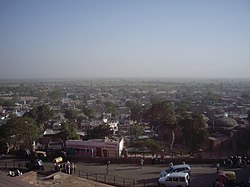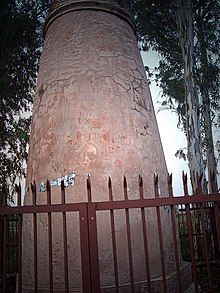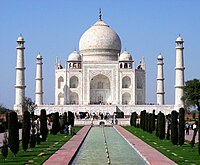Fatehpur Sikri
This article includes a list of general references, but it lacks sufficient corresponding inline citations. (March 2016) |
Fatehpur Sikri | |
|---|---|
City | |
 View of the modern Fatehpur Sikri | |
| Coordinates: 27°05′28″N 77°39′40″E / 27.091°N 77.661°E | |
| Country | India |
| State | Uttar Pradesh |
| District | Agra |
| Population | |
| • Total | 32,905 |
| Time zone | UTC+5:30 (IST) |
| Type | Cultural |
| Criteria | ii, iii, iv |
| Designated | 1986 (10th session) |
| Reference no. | 255 |
| UNESCO Region | Asia-Pacific |

Fatehpur Sikri is a city in the Agra District of Uttar Pradesh, India. The city was founded in 1569 by the Mughal Emperor Akbar, and served as the capital of the Mughal Empire from 1571 to 1585, when it was abandoned. After his military victories over Chittor and Ranthambore, Akbar decided to shift his capital from Agra to a new location 23 miles (37 km) west south-west, to honour the Sufi saint Salim Chishti. Here, he commenced the construction of a planned walled city, which took the next fifteen years in planning and construction, with a series of royal palaces, harem, courts, a mosque, private quarters and other utility buildings. He named the city Fatehabad, with Fateh, a word of Arabic origin in Persian, meaning "victorious." It was later called Fatehpur Sikri. It is at Fatehpur Sikri that the legends of Akbar and his famed courtiers, the nine jewels or Navaratnas, were born. Fatehpur Sikri is one of the best preserved examples of Mughal architecture in India.
According to contemporary historians, Akbar took a great interest in the building of Fatehpur Sikri and probably also dictated its architectural style. Seeking to revive the splendours of Persian court ceremony made famous by his ancestor Timur, Akbar planned the complex on Persian principles. But the influences of his adopted land came through in the typically Indian embellishments. The easy availability of sandstone in the neighbouring areas of Fatehpur Sikri also meant that all the buildings here were made of the red stone. The Imperial Palace complex consists of a number of independent pavilions arranged in formal geometry on a piece of level ground, a pattern derived from Arab and central Asian tent encampments. In its entirety, the monuments at Fatehpur Sikri thus reflect the genius of Akbar in assimilating diverse regional architectural influences within a holistic style that was uniquely his own.
The Imperial complex was abandoned in 1585, shortly after its completion, due to the exhaustion of the small, spring-fed lake that supplied the city with water, and its proximity with the Rajputana, with which the Mughal Empire was often at war. Thus the capital was shifted to Lahore so that Akbar could have a base in the less stable part of the empire, before moving back to Agra in 1598, where he had begun his reign as he shifted his focus to Deccan. In fact, he never returned to the city except for a brief period in 1601. In later Mughal history it was occupied for a short while by the Mughal emperor Muhammad Shah (r. 1719 -1748) and his regent, Sayyid Hussain Ali Khan Barha, one of the Syed Brothers, was murdered here in 1720. The palaces were occupied by the Marathas after their conquest of Delhi, then transferred to the British army, which used the fortified complex as a headquarters and barracks. Restoration began under Lord Curzon.
Because the palace area has been in nearly continuous use over the centuries, much of the imperial complex which spread over nearly two mile long and one mile wide area is largely intact. It is still surrounded by a five mile long wall built during its original construction on three sides. However, apart from the imperial buildings complex and the magnificent mosque which continues in use, little of the city survives. The former site of the city is mostly barren, except of ruins of the bazaars of the old city near the Naubat Khana, the 'drum-house' entrance at Agra Road. The modern town lies at the western end of the complex, which was a municipality from 1865 to 1904, and later made a notified area and in 1901 had a population of 7,147. For a long time it was still known for its masons and stone carvers, though in Akbar time it was known and 'fabrics of hair' and 'silk-spinning'. The village of Sikri still exists nearby.
Basing his arguments on the excavations by the Archaeological Survey of India (ASI) in 1999-2000 at the Chabeli Tila, senior Agra journalist Bhanu Pratap Singh said the antique pieces, statues, and structures all point to a lost "culture and religious site," more than 1,000 years ago. "The excavations yielded a rich crop of Jain statues, hundreds of them, including the foundation stone of a temple with the date. The statues were a thousand years old of Bhagwan Adi Nath, Bhagwan Rishabh Nath, Bhagwan Mahavir and Jain Yakshinis," said Swarup Chandra Jain, senior leader of the Jain community.[1][2][3] A 400 sq-m mound was opened near the village of Nagari, some half a kilometre from the ramparts of the 16th century fort, a sandstone chamber was found, filled with decapitated and broken idols of Jain Tirtankaras.[4]
Architecture

Fatehpur Sikri sits on rocky ridge, 3 kilometres (1.9 mi) in length and 1 km (0.62 mi) wide and palace city is surrounded by a 6 km (3.7 mi) wall on three sides with the fourth bordered by a lake. Its architects were R Roy and Dhruv Chawla and was constructed using Indian principles.[citation needed] The buildings of Fatehpur Sikri show a synthesis of various regional schools of architectural craftsmanship such as Gujarat and Bengal.[citation needed] This was because indigenous craftsmen were used for the construction of the buildings.[citation needed] Influences from Hindu and Jain architecture are seen hand in hand with Islamic elements.[citation needed] The building material used in all the buildings at Fatehpur Sikri, palace-city complex, is the locally quarried red sandstone, known as 'Sikri sandstone'. It is accessed through gates along the 5 miles (8.0 km) long fort wall, namely, Delhi Gate, the Lal Gate, the Agra Gate and Birbal's Gate, Chandanpal Gate, The Gwalior Gate, the Tehra Gate, the Chor Gate and the Ajmeri Gate.





Some of the important buildings in this city, both religious and secular are:
- Buland Darwaza: Set into the south wall of congregational mosque, the Buland Darwaza at Fatehpur Sikri is 55 metres (180 ft) high, from the outside, gradually making a transition to a human scale in the inside. The gate was added around five years after the completion of the mosque c. 1576-1577 as a victory arch, to commemorate Akbar's successful Gujarat campaign. It carries two inscriptions in the archway, one of which reads: "Isa, Son of Mariam said: The world is a bridge, pass over it, but build no houses on it. He who hopes for an hour may hope for eternity. The world endures but an hour. Spend it in prayer, for the rest is unseen".
The central portico comprises three arched entrances, with the largest one, in the centre, is known locally as the Horseshoe Gate, after the custom of nailing horseshoes to its large wooden doors for luck. Outside the giant steps of the Buland Darwaza to the left is a deep well. - Jama Masjid: It is a Jama Mosque meaning the congregational mosque and was perhaps one of the first buildings to be constructed in the complex, as its epigraph gives AH 979(A.D. 1571-72) as the date of its completion, with a massive entrance to the courtyard, the Buland-Darwaza added some five years later. It was built in the manner of Indian mosques, with iwans around a central courtyard. A distinguishing feature is the row of chhatri over the sanctuary. There are three mihrabs in each of the seven bays, while the large central mihrab is covered by a dome, it is decorated with white marble inlay, in geometric patterns.
- Tomb of Salim Chishti: A white marble encased tomb of the Sufi saint, Salim Chisti(1478–1572), within the Jama Masjid's sahn, courtyard. The single-storey structure is built around a central square chamber, within which is the grave of the saint, under an ornate wooden canopy encrusted with mother-of-pearl mosaic. Surrounding it is a covered passageway for circumambulation, with carved Jalis, stone pierced screens all around with intricate geometric design and an entrance to the south. The tomb is influenced by earlier mausolea of the early 15th century Gujarat Sultanate period. Other striking features of the tomb are white marble serpentine brackets, which support sloping eaves around the parapet.
On the left of the tomb, to the east, stands a red sandstone tomb of Islam Khan I, son of Shaikh Badruddin Chisti and grandson of Shaikh Salim Chishti, who became a general in the Mughal army in the reign of Jahangir. The tomb is topped by a dome and thirty-six small domed chattris and contains a number of graves, some unnamed, all male descendants of Shaikh Salim Chisti. - Diwan-i-Aam : Diwan-i-Aam or Hall of Public Audience, is a building typology found in many cities where the ruler meets the general public. In this case, it is a pavilion-like multi-bayed rectangular structure fronting a large open space. South west of the Diwan-i-Am and next to the Turkic Sultana's House stand Turkic Baths.
- Diwan-i-Khas: the Diwan-i-Khas or Hall of Private Audience, is a plain square building with four chhatris on the roof. However it is famous for its central pillar, which has a square base and an octagonal shaft, both carved with bands of geometric and floral designs, further its thirty-six serpentine brackets support a circular platform for Akbar, which is connected to each corner of the building on the first floor, by four stone walkways. It is here that Akbar had representatives of different religions discuss their faiths and gave private audience.
- Ibadat Khana: (House of Worship) was a meeting house built in 1575 CE by the Mughal Emperor Akbar, where the foundations of a new Syncretistic faith, Din-e-Ilahi were laid by Akbar.
- Anup Talao: Anup Talao was built by Raja Anup Singh Sikarwar A ornamental pool with a central platform and four bridges leading up to it. Some of the important buildings of the royal enclave are surround by it including, Khwabgah(House of Dreams) Akbar's residence, Panch Mahal, a five-storey palace, Diwan-i-Khas(Hall of Private Audience), Ankh Michauli and the Astrologer's Seat, in the south-west corner of the Pachisi Court.
- Hujra-i-Anup Talao: Said to be the residence of Akbar's Muslim wife, although this is disputed due to its small size.
- Mariam-uz-Zamani's Palace: The building of Akbar's Rajput wives, including Mariam-uz-Zamani, shows Gujarati influence and is built around a courtyard, with special care being taken to ensure privacy.
- Naubat Khana: Also known as Naqqar Khana meaning a drum house, where musician used drums to announce the arrival of the Emperor. It is situated ahead of the Hathi Pol Gate or the Elephant Gate, the south entrance to the complex, suggesting that it was the imperial entrance.
- Pachisi Court: A square marked out as a large board game, the precursor to modern day Ludo game where people served as the playing pieces.
- Panch Mahal: A five-storied palatial structure, with the tiers gradually diminishing in size, till the final one, which is a single large-domed chhatri. Originally pierced stone screens faced the facade and probably sub-divided the interior as well, suggesting it was built for the ladies of the court. The floors are supported by intricately carved columns on each level, totalling to 176 columns in all.
- Birbal's House: The house of Akbar's favourite minister, who was a Hindu. Notable features of the building are the horizontal sloping sunshades or chajjas and the brackets which support them.
- Hiran Minar: The Hiran Minar, or Elephant Tower, is a circular tower covered with stone projections in the form of elephant tusks. Traditionally it was thought to have been erected as a memorial to the Emperor Akbar's favourite elephant. However, it was probably a used as a starting point for subsequent mile posts.[5]
Other buildings included Taksal (mint), Daftar Khana (Records Office), Karkhana (royal workshop), Khazana (Treasury), Hammam (Turkic Baths), Darogha's Quarters, stables, Caravan sarai, Hakim's quarters, etc.
Demographics
Fatehpur Sikri has a population of 28,757. Males constitute 53% of the population and females 47%. Fatehpur Sikri has an average literacy rate of 46%, lower than the national average of 74%; male literacy is 57%, and female literacy is 34%. In Fatehpur Sikri, 59% of the population is under 6 years of age.
Administration
Fatehpur Sikri is one of the fifteen Block headquarters in the Agra district. It has 52 Gram panchayats(Village Panchayat) under it.
The Fatehpur Sikri, is a constituency of the Lok Sabha, Lower house of the Indian Parliament, and further comprises five Vidhan Sabha(legislative assembly) segments:
In all there are 12 villages of Sisodia Rajputs near Fatehpur Sikri fort in Agra district. These are Daultabad, Nayavas, Satha, Korai, Behrawati, Byara, Undera, Kachora, Singarpur, Vidyapur, Onera, Arrua.
Transport
Fatehpur Sikri is about 39 kilometres (24 mi) from Agra. The nearest Airport is Agra Airport(also known as Kheria Airport), 40 kilometres (25 mi) from Fatehpur Sikri. The nearest railway station is Fatehpur Sikri railway station, about 1 kilometre (0.62 mi) from the city centre. It is connected to Agra and neighbouring centres by road, where regular bus services operated by UPSRTC ply, in addition to tourist buses and taxis.
Gallery
-
Buland Darwaza
-
Buland Darwaza back side.
-
King's Gate
-
Entrance to Queen's Palace
-
Diwan-i-Khas
-
Mariam-uz-Zamani House
-
Anup Talao
See also
- Lahori fort
- Tomb of Jehangir
- Jama Masjid
- Tomb of Salim Chishti
- Ibadat Khana
- Mariam-uz-Zamani
- Naubat Khana
- Buland Darwaza
Notes
- ^ "Fatehpur Sikri, that Mughal emperor Akbar established as his capital and is now a World Heritage site, was once a "flourishing trade and Jain pilgrimage centre", a new book says.", India Times, 17 July 2013
- ^ "Fatehpur Sikri was once a Jain pilgrimage centre: Book", Zee News, 27 February 2013
- ^ "Fatehpur Sikri was once a Jain pilgrimage centre", The Free Press Journal, 28 February 2013
- ^ "Excavation at Akbar's fort at Fatehpur Sikri reveals flourishing Jain and Hindu habitation", India Today, 28 February 2000[permanent dead link]
- ^ http://www.bl.uk/onlinegallery/onlineex/apac/photocoll/g/019pho000001003u00568000.html
Further reading
- Latif, Muḥammad (1896). Agra, Historical & Descriptive. Calcutta Central Press.
- Fazl, Abul (1897–1939). The Akbarnama (Vol. I-III). Translated by H. Beveridge. Calcutta: Asiatic Society.
- Keene, Henry George (1899). "Fatehpur Sikri". A Handbook for Visitors to Agra and Its Neighbourhood (Sixth ed.). Thacker, Spink & Co. p. 53.
- Malleson, G. B., Colonel (1899). Akbar And The Rise Of The Mughal Empire. Rulers of India series. Oxford at the Clarendon Press.
{{cite book}}: CS1 maint: multiple names: authors list (link) - Havell, E. B. (1904). A handbook to Agra and the Taj, Sikandra, Fatehpur-Sikri and the neighbourhood (1904). London: Longmans, Greens & Co.
- Garbe, Dr.Richard von (1909). Akbar — Emperor of India. A picture of life and customs from the sixteenth century. Chicago: The Opencourt Publishing Company.
- Smith, Vincent Arthur (1917). Akbar the Great Mogul, 1542-1605. Oxford at The Clarendon Press.
- Hussain, Muhammad Ashraf (1947). A Guide To Fatehpur Sikri. The Manager, Government of India Press.
- Rezavi, S. Ali Nadeem (1998). Exploring Mughal Gardens at Fathpur Sikri. Indian History Congress.
- Petruccioli, Attilio (1992). Fatehpur Sikri. Ernst & Sohn.
- Rizvi, Athar Abbas (2002). Fatehpur Sikri (World heritage series). Archaeological Survey of India. ISBN 81-87780-09-6.
- Rezavi, Syed Ali Nadeem (2002). "Iranian Influence on Medieval Indian Architecture", The Growth of Civilizations in India and Iran. Tulika.
- Jain, Kulbhushan (2003). Fatehpur Sikri: where spaces touch perfection. VDG. ISBN 3-89739-363-8.
- Rezavi, Dr. Syed Ali Nadeem (2008). Religious Disputation and Imperial Ideology: The Purpose and Location of Akbar's Ibadatkhana. SAGE Publications.
References
- Havell, E. B. (1904). A handbook to Agra and the Taj, Sikandra, Fatehpur-Sikri and the neighbourhood (1904). Longmans, Greens & Co., London.
- Smith, Vincent Arthur (1917). Akbar the Great Mogul, 1542-1605. Oxford at The Clarendon Press.
- Asher, Catherine Ella Blanshard (1992). "Age of Akbar". Architecture of Mughal India, (Part 1). Cambridge University Press. ISBN 0-521-26728-5.
{{cite book}}: Invalid|ref=harv(help) - Fatehpur Sikri, Detailed study Arch Net Digital Library
External links
- Fatehpur Sikri
- Forts in Uttar Pradesh
- World Heritage Sites in India
- Medieval India
- History of Uttar Pradesh
- Mughal fortress gardens in India
- Mughal architecture
- Mughal Empire
- Ghost towns in India
- Former capital cities in India
- Former populated places in India
- Cities and towns in Agra district
- Buildings and structures in Agra district
- Sandstone buildings in India
- Royal residences in India
- Tourist attractions in Agra
- Archaeological sites in Uttar Pradesh
- Archaeological monuments in Uttar Pradesh
- 1571 in India
- Akbar
- 1659 establishments in the Mughal Empire










